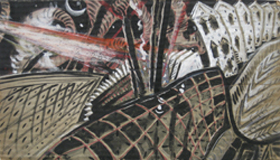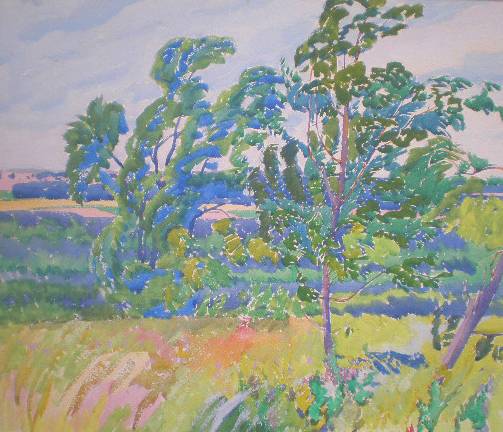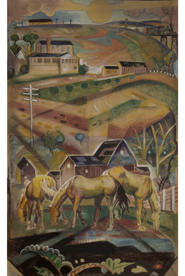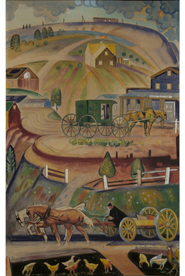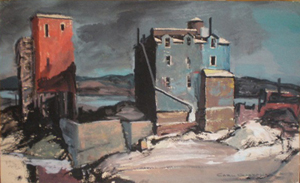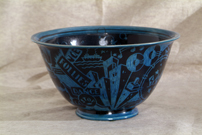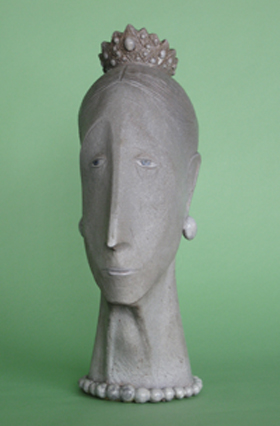From the Encyclopedia of Cleveland History
MUSIC. Music in Cleveland can date its present eminence from the first decades of the 20th century. By that time, population growth and business success had reached a plateau from which could emerge significant cultural events. It was during this era that the dedicated impresaria ADELLA PRENTISS HUGHES†, working through the FORTNIGHTLY MUSICAL CLUB and the Natl. Fed. of Music Clubs, brought the great names of western music to the city–Paderewski, Richard Strauss, Enrico Caruso; the orchestras from Boston, Chicago, New York, Philadelphia, and others; the Ballet Russe, and more. During this time, music making by local ensembles of all kinds was at a new height. The CLEVELAND MUSIC SCHOOL SETTLEMENT (1912), theCLEVELAND INSTITUTE OF MUSIC (1920), and the CLEVELAND MUSEUM OF ART (1916) came into being. At a benefit program for St. Ann Roman Catholic Church at GRAYS ARMORY on 11 Dec. 1918, the fledgling CLEVELAND ORCHESTRA was born. From its earliest days, music making had sprung naturally from the community. The earliest concert recorded in the Annals of Cleveland was a program of sacred music that took place at P. Mowrey’s assembly room on 10 May 1821. Throughout the period before the Civil War, the Annals record an increasing string of musical events, including the formation of such musical groups as the CLEVELAND HARMONIC SOCIETY (1835), the CLEVELAND MOZART SOCIETY (1837), the CLEVELAND MENDELSSOHN SOCIETY (1850), and the ST. CECILIA SOCIETY (1852). Notable early OPERA was produced by the Cleveland Gesangverein.
For much of this period, Cleveland remained in the musical orbit of Boston. This influence was epitomized in the person of Lowell Mason (1792-1872), probably the most influential musician in 19th-century America, who conducted a seminal series of workshops in Cleveland during the 1840s. This tradition did not emphasize American resources but, rather, sought to propagate standards of “correct taste” as practiced in Europe. Mason’s teachings had far-ranging implications for the development of music in Cleveland, particularly in the areas of sacred music and music education. Emphasis on sacred music was particularly strong, and the church was a major supporter of the arts. A Shaker colony known as NORTH UNION SHAKER COMMUNITY (in SHAKER HEIGHTS) was formed ca. 1822 and saw its most prosperous days between 1840-58 (it dissolved in 1899). Devotional vocal music, sung in unison without instruments, formed the core repertory for its dance-oriented religious meetings.
The first full-time supervisor in the Cleveland public schools was a disciple of Lowell Mason by the name of N. COE STEWART†, who held this post over a long tenure (1869-1907). Band music was highly popular in 19th-century Cleveland, and for many was a principal source of musical exposure. Playing in parks, in concert halls, at lawn fetes, on lake steamers, in skating rinks, at conventions, at strawberry festivals, and at numerous special events, visiting and local BANDS seemed omnipresent.
Waves of immigrants coming from Europe reached Cleveland before and after the Civil War, making the city the 7th-largest in the nation by 1900. Among these, the GERMANS were particularly skilled in music, and it was Cleveland’s German community that was responsible for much of the music making during the 19th century. The first German singing society in Cleveland was the FROHSINN SINGING SOCIETY in 1848, followed by the Cleveland Gesangverein in 1854. German groups in America began to exchange visits, becoming more formally organized following a gathering of singers in Cincinnati in June 1849. From that time, regular “SAENGERFESTS” took place, alternating between cities, over a long period of time. Five such saengerfests were held in Cleveland between 1855 and 1927. These events combined social activities, including picnics, torchlight processions, dinners, and balls, along with the concerts. Hans Balatka (1855), F. Abel (1859), Carl Bergmann (1874), EMIL RING† (1893), and Bruno Walter (1927) served as festival conductors. The final festival, which honored Ludwig van Beethoven, recognized also Cleveland composer ALBERT GEHRING† and combined more than 100 societies and 4,000 singers. Cincinnati served as a model for Cleveland in other ways. A saengerfest held there in May 1873 under the skillful leadership of Theodore Thomas (1835-1905), one of 19th-century America’s best conductors, provided momentum for a series of May festivals to follow. Such large events were much a part of the American scene during these years, and one need only point to the peace jubilees in Boston in 1869 and 1872 for other examples.
The impact of these events was not lost on Cleveland, and the person in a position to do something about it was Cleveland’s most important choral conductor, ALFRED ARTHUR†. His greatest achievement lay in his work with the CLEVELAND VOCAL SOCIETY, an organization that he conducted 29 seasons, through the spring of 1902. It was responsible for important first performances here, for entertaining renowned guests such as violinist Eduard Remenyi and composer Max Bruch, and for representing Cleveland with distinction at the World’s Columbian Exposition in Chicago in 1893. Finally, Arthur was responsible for landmark orchestral concerts; 4 programs took place in Mar.-Apr. 1872 at Brainard’s Piano Ware Rooms. A new ensemble, the Cleveland Amateur Philharmonic Society, came into being in 1881, with FERDINAND PUEHRINGER† as its first conductor. Mueller Neuhoff succeeded Puehringer, to be replaced in turn by Franz Arens. In 1888 the Austrian oboist, composer, and conductor Emil Ring, who had first come to America in 1887 as a member of the Boston Symphony Orchestra, arrived to conduct the ensemble. Ring, a leader of obvious ability, gave programs of breadth, including works by Liszt, Wagner, Berlioz, Massenet, and Grieg. There were about 4 regular concerts each year, and the orchestra accompanied choral works for the Gesangverein, of which Ring was also the conductor, in summer programs at HALTNORTH’S GARDENS.
During the early 1900s, several local orchestras graced the growing scene, led by Emil Ring and a Cleveland-born colleague, . The short-livedCLEVELAND SYMPHONY ORCHESTRA with Beck as conductor represents an important venture in 1900-01. The 50-piece ensemble gave a total of 8 concerts at Grays Armory, with important soloists a regular feature. After the demise of this ensemble, the CLEVELAND GRAND ORCHESTRA came into being, playing a series of “Citizens’ Pop Concerts” through 1909 (the 1904-05 season prospectus advertised simply the “Cleveland Orchestra”). Audiences evidently were large, and ticket prices low; deficits were met through timely contributions. Although the fare aimed first of all to entertain, the repertoire included its share of works by Beethoven, Mendelssohn, Schubert, and other established composers. The series continued from 1910-12 under the name People’s Symphony Concerts, with the orchestra now called the Cleveland Symphony Orchestra, under the alternate direction of Ring and Beck. A short-lived experiment was the organization of the Cleveland Municipal Symphony Orchestra, the financial support for which was taken over by the city. Notable though the intentions were, the conductor brought here to lead the orchestra, Dutch violinist Christiaan Timmner, eventually proved unable to develop the ensemble, and it dissolved in Mar. 1915. The next step was the tenuous beginning of the Cleveland Orchestra itself, known in its first season as Cleveland’s Symphony Orchestra. The press was enthusiastic. The ensemble of about 60 players, conducted by NIKOLAI SOKOLOFF†, was recruited mainly from the best local talent. It performed a varied schedule of more than 2 dozen programs its first season, to June 1919. The time was right; Cleveland at last had an orchestra that would endure.
Even as Cleveland was developing its own musical resources during the period to 1918, many musical visitors of importance helped shape standards of musical excellence and allowed Clevelanders to comprehend more clearly their emerging role on the national scene. The Norwegian violinist Ole Bull made repeated visits beginning in the 1840s. The Manvers Operatic Co., probably the first opera company to come, in 1849, started a tradition that culminated in the regular series by New York’s Metropolitan Opera (1899-1986). Jenny Lind (see JENNY LIND TOUR), the Hutchinson family, Adelina Patti, Louis Moreau Gottschalk, Patrick Sarsfield Gilmore, John Philip Sousa, and many more gave programs. In the orchestral sphere, Theodore Thomas made Cleveland a regular stop after 1869. Chamber music also flourished. The Cecilian String Quartet, begun in 1875, was a pioneer. Back in Cleveland after a time of study in Leipzig, Johann Beck organized the SCHUBERT STRING QUARTET 3 years later; it gave numerous concerts during the 1880s. The successor to this group was the BECK STRING QUARTET, which made its debut on 16 Oct. 1890 in a concert in the chapel of Unity Church. ThePHILHARMONIC STRING QUARTET was an important presence well into this century, and other groups followed. In Nov. 1918 the Chamber Music Society of Cleveland was formed, a precursor of the present CLEVELAND CHAMBER MUSIC SOCIETY.
Chronicler to Cleveland music during the second half of the 19th century was the important firm of ARTHUR SHEPHERD†, to many the “dean” of Cleveland composers, who came here in 1920 as asst. conductor of the Cleveland Orchestra, and remained to compose and become long-time head of music at Western Reserve Univ. Other composers who have been a part of the Cleveland scene during the last half-century include VICTOR BABIN†, Rudolph Bubalo, Marcel Dick, Dennis Eberhard, HERBERT ELWELL†, Donald Erb, Edwin London, J. D. BAIN MURRAY†, Eugene O’Brien, Klaus George Roy, and BERYL RUBINSTEIN†. Others, associated primarily elsewhere, who contributed include ERNEST BLOCH† (who came to Cleveland in 1920 to lead the newly formed Cleveland Institute of Music), Douglas Moore, Quincy Porter, Roger Sessions, and Raymond Wilding-White. There is an activeCLEVELAND COMPOSERS’ GUILD, formed during the 1920s. Instrument building in Cleveland has played an important role. Significant among the builders are the Holtkamp Organ Co. (see WALTER HOLTKAMP†), and the KING MUSICAL INSTRUMENTS CO., makers of brass instruments.
Subsequent conductors of the Cleveland Orchestra who have fulfilled the promise are ARTUR RODZINSKI† (1933-43), Erich Leinsdorf (1943-46), GEO. SZELL† (1946-70), Lorin Maazel (1972-82), and Christoph von Dohnanyi (1984- ). Pierre Boulez and Louis Lane also contributed immeasurably during the period 1970-72. A Cleveland Orchestra Chorus was formed (continuous from 1955), reaching an early high point during the tenure here (1956-67) of Robt. Shaw, and continuing to high acclaim under its subsequent directors, now Gareth Morrell. A Children’s Chorus, affiliated with the orchestra, was formed in 1967. The orchestra gives about 30 summer concerts annually at its summer home, the Blossom Music Ctr. (inaugurated 1968), where “popular” concerts increase the number to approximately 70 yearly events during the June-Sept. season. Important later contributors to the music scene have been the curators of musical arts at the Cleveland Museum of Art, Thos. Whitney Surette (1921-40), WALTER BLODGETT† (1940-74), and Karel Paukert (1974- ). The McMyler organ (1922), the first in this country to be installed in a museum of art, and pace-setting in its design principles, was moved and rebuilt in a new auditorium in 1971. In 1994 David Cerone was president of the Cleveland Institute of Music, succeeding Victor Babin and, more recently, Grant Johannesen. Ross Duffin was chairman of the Music Dept. at CASE WESTERN RESERVE UNIVERSITY. in 1993. The Music Dept. of CLEVELAND STATE UNIVERSITY, which developed under a long tenure by Julius Drossin, was, in 1994, led by Howard Meeker. The CLEVELAND MUSIC SCHOOL SETTLEMENT, one of the largest community music schools in the country, with over 5,000 students, with branches and affiliates in several locations, grew under long-time director, HOWARD WHITTAKER†, and in 1994 was headed by Robert McAllister. Significant contributions are also made by neighboring institutions BALDWIN-WALLACE COLLEGE, Oberlin College, and Kent State Univ.
Cleveland’s numerous ethnic neighborhoods have added rich variety. Besides the Germans, many other groups have contributed. The CIURLIONIS LITHUANIAN NATIONAL ART ENSEMBLE came to Cleveland in 1949 after extensive concertizing in Europe. The CLEVELAND KILTIE BAND, founded in 1935 to preserve the art of Scottish bagpipers, has been important here. The Balmoral Dancers became a part of this organization. TheGLASBENA MATICA has been important to the cultural life of the Cleveland SLOVENES. Representing the renowned Welsh singing tradition here have been the gatherings of the Gymanfa Ganu and, among others, the Cleveland Messiah Chorus. The HARMONIA CHOPIN SINGING SOCIETY, founded in 1902, was the first Polish male chorus in Ohio. The Hungaria Singing Society dates back to the 1890s. Ireland is represented by the Irish Musicians Assn. of America, Michael Keating Branch. The recently disbanded Czech LUMIR-HLAHOL-TYL SINGING SOCIETY was founded in Cleveland, and in 1898 presented the first performance here of Smetana’s The Bartered Bride. The oldest and largest of the Yugoslav choirs in Cleveland has been the Serbian Singing Choir. Children’s music has been represented in a number of directions, including the Zagreb Junior Tamburitzans and the more mainstreamSINGING ANGELS.
Cleveland has been a vital center of the more “popular” genres. Parlor music–that genre consisting mainly of piano music and songs aimed at the home market, particularly women–was as widespread in 19th-century Cleveland as it was elsewhere. Nearly half of the pages of Brainard’s (Western) Musical World were filled with music of this sort, mainly by Americans. Music produced in Musical World was, of course, also readily available for sale. Moving ahead in time, popular song, JAZZ, Americanized POLKAS, musical theater, and ROCK ‘N’ ROLL have all been important here. Famous songwriterERNEST R. BALL† (1878-1927) was born in Cleveland, and Art Tatum spent several seasons playing in Cleveland clubs during the 1930s. Tadd Dameron, Benny Bailey, Albert Ayler, and a host of others graced the local scene. A special Cleveland contribution lies in the inception here of rock ‘n’ roll, brought to prominence in the early 1950s in Cleveland before it achieved its phenomenal international popularity.
Evidence of Cleveland’s continuing growth in the musical arts can be seen in a variety of local ensembles of merit. The CLEVELAND CHAMBER SYMPHONY (1980- ), Edwin London, conductor, and the OHIO CHAMBER ORCHESTRA (1972- ), David Lockington, director, have joined older groups, including the CLEVELAND WOMEN’S ORCHESTRA (1925- ), the oldest women’s orchestra in the nation, founded and conducted for many years by HYMAN SCHANDLER†; the CLEVELAND PHILHARMONIC ORCHESTRA (1938- ), William Slocum, conductor; and the SUBURBAN SYMPHONY ORCHESTRA (1954- ), Martin Kessler, conductor. Other important groups include the SINGERS CLUB (1893- ), Thomas Shellhammer, conductor, and Apollo’s Fire, Jeannette Sorrell, conductor. Opera and ballet have especially flourished in Cleveland during recent years. Two opera companies, CLEVELAND OPERA (1976- ) and LYRIC OPERA CLEVELAND (formerly Cleveland Opera Theatre; autonomous since 1976) mount important productions. The CLEVELAND BALLET (1974- ) does excellent work. Concerts supported successfully at educational institutions and through such organizations as the CLEVELAND CHAMBER MUSIC SOCIETY (1949- ), the Rocky River Chamber Music Society, and the Cleveland Museum of Art add greatly. Private organizations sponsoring concerts include the THREE ARTS CLUB OF LAKEWOOD (1918- ), and the Fortnightly Musical Club (1894-). Church music series, notably the Brownbag Concerts at TRINITY CATHEDRAL, under the leadership of Daniel Hathaway, often contribute in important ways. Good musical instruction at various levels, good library collections, and good newspaper reporting by HERBERT ELWELL†, Robt. Finn, Wilma Salisbury, Frank Hruby (of the musical HRUBY FAMILY), J. D. Bain Murray, Donald Rosenberg, and others have helped bring Cleveland concertgoers to new levels of sophistication. A model across the nation has become the program notes produced for Severance Hall. Program-book annotator Klaus G. Roy, now retired, was replaced by Peter Laki. Young Audiences of Greater Cleveland, autonomous since 1977, has been increasingly active in bringing relevant programs of excellence into school situations.
Patterns of funding for arts organizations have changed dramatically in recent years. Particularly since the creation in 1964 of the Natl. Council on the Arts and in 1965 of the Natl. Foundation on the Arts & Humanities, with its components, the Natl. Endowment for the Arts and the Natl. Endowment for the Humanities, the federal government has come to play an increasingly important role. At the state level, the Ohio Arts Council, which has contributed much in support of music, was also founded in 1965. Competition for funds, however, and “crisis financing” continue to hamper musical organizations as an increasing number of these vie for existing funds. As federal programs are cut because of the huge national deficit, and as funding in general becomes more elusive, musical organizations are finding they must learn better to manage their own affairs as well as to sharpen their focus and public image. Public relations has developed as an increasingly important field of professional concern. Indicative is the growth of arts administration as a professional field. The newly established and smaller musical groups have a particularly hard time, not only because of the problems of building constituencies but also because foundations and corporations have traditionally been cautious in supporting such groups.
Funding problems and opportunities, as well as demographic changes within the Greater Cleveland area, have brought about fundamental changes for Cleveland’s musical enterprises. Support for major organizations remains strong but now rests on a broader base. A number of foundations, including theCLEVELAND FOUNDATION, the KULAS FOUNDATION, and the Bascom Little Fund, provide needed help. Cleveland has built over its history a viable music-making and music-listening community and has gained for itself an international reputation for music. The signs are that that reputation will continue to deepen and grow.
J. Heywood Alexander
Cleveland State Univ.
Alexander, J. Heywood. It Must Be Heard (1981).
Grossman, F. Karl. A History of Music in Cleveland (1972).
Witchey, Holly Rarick. Fine Arts in Cleveland: An Illustrated History (1994).

